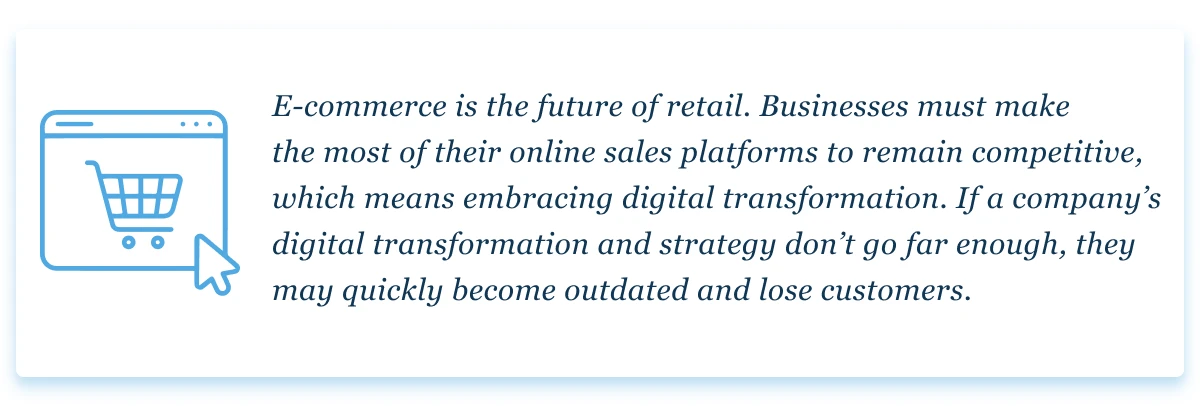Digital transformation and E-commerce may seem like they go hand-in-hand, but that’s not always the case. While the latter is often part of companies’ digital strategies, digital transformation in E-commerce isn’t always what it could be. Despite — and partly because of — that oversight, it’s becoming increasingly crucial for E-commerce businesses to embrace digital transformation.
What is digital transformation?
Before moving on, it’s important to understand what exactly digital transformation is. In general, digital transformation refers to replacing conventional business processes with digital alternatives. That covers everything from switching from on-premise computing to the cloud to using data analytics to automating some processes.
As digitization has increased, the standard for digital strategy and transformation is rising. Organizations already relying on digital tools can still innovate further to get more value from them. They may use artificial intelligence in digital transformation to automate more than previously possible, bring all devices into one network instead of just a few, or make cybersecurity part of every workflow.
The specifics of digital transformation vary widely between companies. In all aspects, though, it seeks to optimize a process by embracing or extending new digital technologies over the conventional.
The importance of E-commerce digital transformation
At first, the concept of digital transformation in E-commerce may seem redundant. After all, online shopping is a digital alternative to brick-and-mortar stores, so an E-commerce business plan is a form of digital transformation for traditional retailers. However, new technologies let this digitization go even further.
Many E-commerce operations aren’t living up to their full digital potential. Some don’t meet users’ expectations about convenience, speed, or transparency. Others don’t take advantage of the recent tech innovations in E-commerce that lower costs or unlock higher efficiency.

Digital transformation strategies for E-commerce
The journey to making the most of E-commerce starts with a specific strategy for digital transformation. Different businesses have varying needs, but here are a few of the most popular digital transformation strategies for E-commerce operations.
AI and automation
Automation and AI are some of the most promising digital technologies for E-commerce businesses today. E-commerce involves a lot of moving parts when considering behind-the-scenes operations like warehousing and shipping. When all of these processes are manual, it leads to mistakes and slow shipping times, costing companies customers.
Robotic process automation (RPA) can automate things like data entry, managing inventory records, and updating product descriptions or availability listings. New technologies like generative artificial intelligence can automate even more. Generative AI can reach out to customers or personalize marketing materials without human input.

Source: Unsplash
In all use cases, AI and automation reduce errors and streamline processes. That’s crucial in E-commerce, where 32% of global shoppers have abandoned a purchase because the order would take too long.
Omnichannel support
Multichannel and omnichannel marketing strategies and services are another key digital transformation strategy. While E-commerce is slowly taking over more and more of overall retail sales, people still shop in stores. They also expect the same level of service and convenience in both experiences.
Similarly, most businesses today understand that marketing is more effective when it’s personalized. Personalizing content across all channels — on social media platforms, in-store, on TV, and everywhere else — maximizes that efficacy. That level of customization and consistent service is only possible with technologies like big data analytics and automation.
Collecting and combining customer data across channels gives even small business E-commerce platforms the insight they need for in-depth personalization. Automation can apply this customization across all platforms to ensure a consistent experience. This digital transformation, in turn, makes E-commerce stores more convenient and engaging.
Chatbots for customer service
Many E-commerce digital transformation strategies today also include chatbots. Talking to a customer service agent helps users find what they’re looking for faster, but hosting a live chat option around the clock isn’t practical. AI-powered chatbots provide a solution.
Chatbots can answer up to 80% of user questions or reach out to first-time visitors at any time, regardless of an E-commerce business’s staffing levels. That way, every customer gets the same level of service, no matter when they visit the site. Because AI works faster than humans, chatbots can also resolve some service issues in less time, boosting loyalty.
Generative AI features will make these bots even more helpful over time. If users have more complicated issues, chatbots can assign them to the proper representative. They can also give the service rep a summary of the problem and related resources to help them find the best answer faster. These bots help human employees perform their roles better instead of replacing them.
Augmented and virtual reality
Augmented reality (AR) and virtual reality (VR) are less common but still promising digital transformation applications for E-commerce. These technologies are quickly becoming more accessible and present new ways for E-commerce companies to reach their customers.
AR features on an app or mobile website can let buyers see what they’d look like in a piece of clothing or what furniture would fit in their home without buying it. VR can let them experience new locations or immerse themselves in a virtual storefront full of products without leaving their house.
Both AR and VR make E-commerce more convenient than previously possible. Because interactivity and visuals boost engagement, they also help users get more excited about or familiar with a brand. Sales and client loyalty will increase as a result.
Agile supply chains
Supply chain optimization is another easy-to-overlook but crucial strategy for digital transformation. Modern customers want shipping to be fast, transparent, and reliable. However, conventional supply chains are hard to track and prone to disruption, so they can’t effectively meet those goals. Digitization helps.
E-commerce websites can embrace the digital supply chain in several ways. They could use Internet of Things (IoT) tracking to get real-time updates on shipments. They could analyze supply chain data with machine learning to learn how to improve it. Some companies go even further and use robots in their warehouses to prevent injuries and work faster.

Source: Unsplash
In all these use cases, supply chain digitization makes tracking shipments easier and ensures things arrive on time. E-commerce businesses can then impress customers with fast, reliable shipping, fewer errors like stock-outs, or let them track their orders in real-time. This convenience helps companies stand out from the 24 million other E-commerce sites on the web today.
Site optimization
Making E-commerce sites more functional is a less glamorous but still important way to apply digital transformation. Lots of online shoppers are younger, digital-native users who expect more from online platforms because they’ve seen more. Online stores must use technology to meet these expectations.
Businesses can turn to reliable cloud services to scale their site’s underlying infrastructure to support more traffic and faster load times. Automated testing tools can highlight issues in the site’s code so teams can fix them before they hinder customer experience. Convenience aside, applications like encryption and AI monitoring make checkout processes safer.
The more time people spend online, the more they’ll expect from the sites they visit. Digital transformation strategies are the key to meeting those demands as they become more extreme.
How to embrace digital transformation in E-commerce
Those in the business of E-commerce should ask if their digital transformation goes far enough. If they decide it’s right for them to lean further into this shift, here’s how these businesses can do so effectively.
Determine needs and goals
The first step in all digital transformation processes is identifying where they’re most useful. It’s best never to use new technologies simply because they’re new and exciting. Instead, view them as an answer to real problems.
Start by reviewing feedback and looking at business processes to find areas with room for improvement. While doing that, consider applicable budgetary or technological constraints. Once companies recognize where their work isn’t ideal, they’ll know where to apply new technology.
The most effective strategy differs between specific needs. Some businesses may find AI revenue management services the most useful, while others will gain more from boosting supply chain transparency. Whatever the specifics, starting with the area where the company can realize the most change enables higher ROIs.
Find the right technology partners
Next, the E-commerce business plan should include a process for finding the right provider for the technology in question. Different companies may offer varying prices, features, and support for the same type of technology.
Businesses without much coding experience should partner with a data science and AI company that can handle the model-building and training for them. Similarly, companies that don’t have a strong culture of cybersecurity yet should prioritize vendors with a strong security track record.
If an E-commerce store has any unique features or needs, they should ensure their vendor can adapt. Partners that support long-term product updates are generally preferable, as digital transformation is a journey.
Maximize data visibility
Whatever specific technology a company implements, it should also emphasize data visibility alongside it. Many digital transformation applications work best when they have large amounts of accurate, relevant data.
An E-commerce business building a digital food supply chain management system should collect as much shipping information as possible through the IoT. Stores using AI to interact with customers should feed it data from customer forms, cookies, and big data partners. In all cases, more information improves results. Part of this process is combining information from multiple sources into a single cloud environment. That way, businesses get the full picture and can find and remove errors, duplicates, and similar issues. Automated data cleansing before analysis will also help.

Source: Unsplash
Ensure security
Digital transformation and E-commerce also require high standards for cybersecurity. All this data can introduce significant risks if companies don’t also ramp up their security.
Teams should emphasize cybersecurity throughout the AI software development cycle, regularly checking for and fixing vulnerabilities. All employees should also learn cybersecurity basics to protect against human-targeted attacks like phishing. Employing the principle of least privilege — which holds that every user, app, and device can only access what it needs to do its job — will further reduce risks.

Digital transformation, E-commerce, and multichannel all work together
When digital transformation and E-commerce come hand-in-hand, companies can capitalize on multichannel marketing, reach a broader audience, impress clients, and remain competitive in a changing market. As retail slowly moves away from brick-and-mortar stores in favor of online shopping, these benefits will become necessities.
Digital transformation isn’t always easy, but with the right partner, it can be highly profitable. E-commerce businesses hoping to outshine their peers can start by seeing where digital technology can take them.
Author bio
April Miller is a senior writer with more than 3 years of experience writing on AI and ML topics.



